Are you a Quiet Speculation member?
If not, now is a perfect time to join up! Our powerful tools, breaking-news analysis, and exclusive Discord channel will make sure you stay up to date and ahead of the curve.
With Dredge now officially (re)axed, Infect presumably hindered as well, and a new set in the mix in the form of Aether Revolt, Modern Magic as we know it is primed for a potentially significant change from the norm. The relatively stable Modern landscape we’ve become accustomed to has suddenly transformed into the Wild West, which should excite even the most depressed Magic player. Soon, we will have a clear picture of the new "life as we know it," but until then, we can only speculate, test, and speculate some more. With that, let’s take our first dive into Modern Magic in 2017, by analyzing the SCG Modern Classic results from Richmond last weekend.
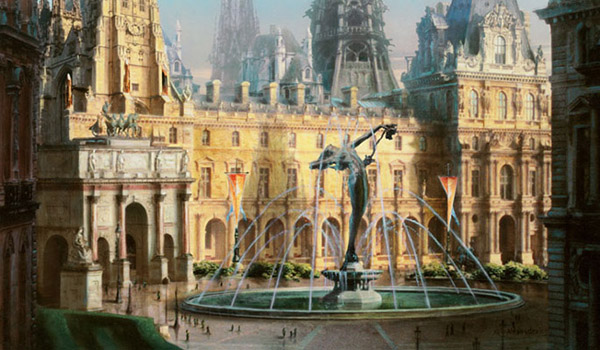
As an aside, I was actually in Richmond for a wedding last weekend, but couldn’t break away to attend the event. “But everything as we know it could possibly change!” was unfortunately not a valid excuse to warrant my absence, so I had to miss out. Still, it would be really nice if some brand new archetype rose from the ashes of the previous format giants like some reborn phoenix to prove my point, but I doubt my newly-wed sister-in-law would care. So, there’s my skin in this game. Fingers crossed for Mono-Green Control or something!
[wp_ad_camp_1]
Top 16 Archetypes
- Goryo's Vengeance
- Burn
- Jeskai Control
- Naya Company
- Jund
- RW Prison
- Jeskai Control
- Abzan Company
- Grixis Delver
- Burn
- Ad Nauseam
- Scapeshift
- Zoo
- Affinity
- Jund
- Taking Turns
Well, so much for that. For those new to how we do things around here, we’ll break down the individual deck lists shortly, but before that we’ll dive in to the archetype data to get a quick sense of how the metagame looks on a surface level.
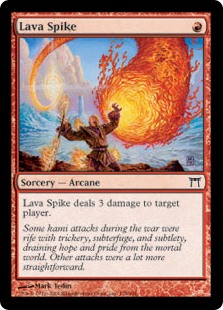 Starting at a macro level, the archetype distribution in the Top 16 is fairly diverse, at least compared to some past environments we’ve seen before. A full thirteen different archetypes are present in the Top 16, with only Jund, Burn and Jeskai Control taking two slots in the final tables. This in itself isn’t totally surprising. Besides, this is one of the first events after all the big shakeups, so it makes sense to see players trying a wide range of things. It also makes sense to see a wide range of things performing, before top decks are found, streamlined, and become represented at levels indicative of their power.
Starting at a macro level, the archetype distribution in the Top 16 is fairly diverse, at least compared to some past environments we’ve seen before. A full thirteen different archetypes are present in the Top 16, with only Jund, Burn and Jeskai Control taking two slots in the final tables. This in itself isn’t totally surprising. Besides, this is one of the first events after all the big shakeups, so it makes sense to see players trying a wide range of things. It also makes sense to see a wide range of things performing, before top decks are found, streamlined, and become represented at levels indicative of their power.
Looking only at the Top 8, a full seven archetypes are represented, which for those counting at home is considered a slam-dunk in the circles that value diversity in Modern. It’s hard to pinpoint a top deck (though the final table makes a strong case for one) without seeing a disparity in representation between archetypes, so step one of solving the puzzle of “best deck” is still up in the air at this point.
As a brief aside, it’s important to recognize that a diverse field isn’t necessarily a ubiquitous sign of format health. Twenty different viable archetypes sounds like a great thing for everyone, but can lead to situations where there are too many things to cover and sideboards can feel like they are stretched too thin. Those familiar with the history of Modern can remember a time not too long ago when the format was exactly like this, and archetype selection/deck composition was more a game of "dodge the hate" than anything else. Rock/Paper/Scissors is one thing, but Rock/Paper/Scissors/Chair/Stapler/Spoon/etc./etc. is something entirely different.
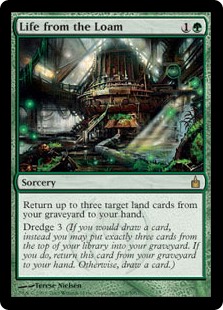 Back to the results at hand, the immediately apparent takeaway for me is the return of midrange to the top of the Modern mound. Pre-banning/Aether Revolt release, all non-Jund midrange had been successfully pushed out of the metagame due to a variety of factors (Bant Eldrazi, ever-faster linear archetypes, etc.) but the true culprit was, definitively, Dredge. What can reactive midrange strategies do against the card advantage engine like Life from the Loam plus Bloodghast? Didn’t draw your hate card? Prepare for a loooooong match.
Back to the results at hand, the immediately apparent takeaway for me is the return of midrange to the top of the Modern mound. Pre-banning/Aether Revolt release, all non-Jund midrange had been successfully pushed out of the metagame due to a variety of factors (Bant Eldrazi, ever-faster linear archetypes, etc.) but the true culprit was, definitively, Dredge. What can reactive midrange strategies do against the card advantage engine like Life from the Loam plus Bloodghast? Didn’t draw your hate card? Prepare for a loooooong match.
With Dredge out of the way (and Infect kicked down a notch as well), it looks like the stage is set for midrange to return back into the fold, at least based on the results of this event. Sure, it didn’t take home the trophy, but when “bad” decks like RW Prison can put up results, you know the format is aligned strongly in midrange’s favor. It’s worth noting that if this format stays in this midrange mold, one of the best ways to fight a reactive format is with some good old fashioned unfair combo.
Goryo's Vengeance, by Christopher Calhoun (1st, SCG Richmond Classic)
One of the most unfair combos left standing after the ban-happy past couple years, Goryo’s Vengeance is a deck still capable of turn-two kills in a turn-four format. On the surface, it seems that of all the decks to benefit the most from the Infect/Dredge demise, Goryo’s Vengeance stands above them all. 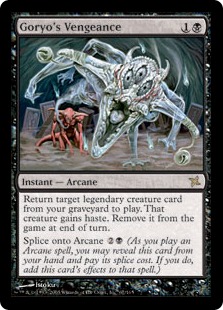 Infect (and Burn) were the best decks in the format that could challenge Goryo’s Vengeance in terms of speed, and with the apparent downgrading of Infect, Goryo’s Vengeance is left free to beat up on the field. With Dredge gone, most of the graveyard hate in the format went with it, which is the best way to fight this archetype as well. Seriously, Terminate and Kolaghan's Command are not going to get things done.
Infect (and Burn) were the best decks in the format that could challenge Goryo’s Vengeance in terms of speed, and with the apparent downgrading of Infect, Goryo’s Vengeance is left free to beat up on the field. With Dredge gone, most of the graveyard hate in the format went with it, which is the best way to fight this archetype as well. Seriously, Terminate and Kolaghan's Command are not going to get things done.
Golgari Grave-Troll might have been the card to get banned, but really it was Cathartic Reunion that pushed the deck (back) over the top. This has created a scenario where the real problem here is Cathartic Reunion, but Grave-Troll took the fall while Goryo's Vengeance still gets to play the problem card. Now, I’m not saying that Wizards should have banned Cathartic Reunion instead. I’m just speaking to the power level of the card and making a point with myself that its inclusion here significantly helps the strategy.
It’s far too early to start talking about Goryo’s Vengeance in terms of "best deck" and "how to beat it," so we’ll stay away from that for now. Instead, I’d like to talk a bit about one of my favorite archetypes...
Jeskai Control, by Matthew Vook (3rd, SCG Richmond Classic)
Nahiri, the Harbinger is back, baby! The format still is (and always was) soft to a four-mana permanent with lots of loyalty, and finally the stars have aligned again for Nahiri to re-take the top end of the curve. Dreadbore remains the best way to kill this threat, which is bad news for every deck that is not Jund. 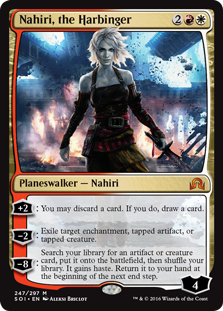 Nahiri, the Harbinger isn’t great against the entire field by any means, but if a significant percentage of the metagame is midrange (which is to be expected for now, at least) then Nahiri, the Harbinger is exactly what I’d like to be doing.
Nahiri, the Harbinger isn’t great against the entire field by any means, but if a significant percentage of the metagame is midrange (which is to be expected for now, at least) then Nahiri, the Harbinger is exactly what I’d like to be doing.
With that being said, we have to talk about Rewind, as a freaking three-of over Cryptic Command! No, no, we can’t use the “he couldn’t afford Cryptic Commands” argument here; this deck is one of the most expensive to build besides Jund. Matthew played Rewind with purpose, and I’m sitting up and taking notice.
So, what does it do? Yes, I know it counters a spell and untaps lands, but how does it contribute to the deck's plan? We can counter a thing and also Snapcaster Mage another spell for value in the same turn, which definitely puts us ahead in the tempo department. We can counter a thing while also flashing in Vendilion Clique at end of turn for more disruption and to advance our board. 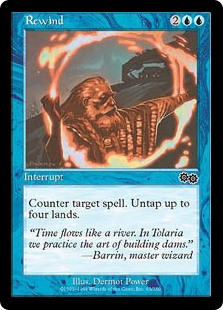 It also combos with Blessed Alliance out of the board, in the sense that we get to play two four-cost spells and feel relatively good while doing so.
It also combos with Blessed Alliance out of the board, in the sense that we get to play two four-cost spells and feel relatively good while doing so.
I don’t know, countering a thing and drawing a card (while also having access to a bunch of other tricks) seems like a much better use for our top-end counterspell of choice, but it’s difficult to argue with the results. One thing I will say is that in many situations where Jeskai Control is living to four mana to cast one of either Rewind or Cryptic Command without immediately dying right after, it should be winning regardless. So, when we are able to cast one of these two spells, it often won't matter much which one we’re casting, as in those situations they both are probably doing similar things to influence the game. This doesn’t help us determine whether one is better than the other, but it does give a possible explanation for why we might be seeing these numbers in the decklist. Now that I’ve said that, watch Rewind become the next big thing that takes over Modern. Crazier things have happened…
Conclusion
This new Modern looks pretty similar to Modern formats of old, at least right out of the gates. This isn’t necessarily a bad thing, as options are fun, especially after such a strict Rock/Paper/Scissors environment in our recent past. We’re just getting started with our exploration of this Wild West, and next week’s results could look vastly different to the ones we’re seeing now. Still, I’m glad to be back analyzing new data, and I’m looking forward to seeing the results start to flow in! What do you think? Let me know in the comments below, and I’ll see you next week!
Trevor Holmes






I noticed rewind too on mtggoldfish but, if you look on the SCG website, it’s remand instead. Wich make more sense to me…
It’s worth mentioning that the 7th place “Jeskai” control deck is actually Azorius control. I would argue that’s a completely different archetype compared to the Jeskai Nahiri decks (I would still make this argument even if it included red, but no Nahiris).
So really it’s 8 different archetypes in the top 8….
DUDE! The next time you’re in Richmond, we need to hook up! (Well, it’s not like we know each other, perhaps I’m just a fan of your work, and I’m a little excited that you were nearby )
)
Great article! I too wasn’t able to attend the event at Richmond, even though I am local (shame on me!). Incidentally, at my FNM last week, I went up against 2 post-ban Dredge decks. They happen to still do well regardless. I was hoping dust off the old side board for my Grixis Control deck (oh Keranos, I knew thee well!), but it looks like I’m still packin’ those Leylines. :\
I look forward to reading about your next event performance, perhaps I’ll see you there! Thanks again for your dedication!
Sorry to burst your bubble. Rewind is reall 3 remands. That typo…
Well indeed Dredge ando inffect are tier 2 but sitio rally powerfull
Nice article Trevor. Guess people will probably side their surgical extractions back in. My lantern deck packs three main and one in board, so I’m not worried about the necropotent demon.
I’m more worried about pact of negation and boseiju allowing reanimator and ad nauseam to get around control decks, the archetype that should be difficult to deal with. I’d only hate to lose SSG because it will flat out kill all spell based combo.
Um, the deck lists 3 Remands, not Rewinds. That said, I’ve preferred Rewind over Cryptic, and for other reasons that doesn’t concern prices. What Rewind can offer on its own, is the ability to counter something and just lose a card, because of the untap clause. That way, you can disrupt the opponent and play something else for value or advancing your position. One route involves Snapcaster, as you said it yourself, and another could be something like Think Twice, Esper Charm, or removal, depending on your deck and style. Other than that, it’s a good read!